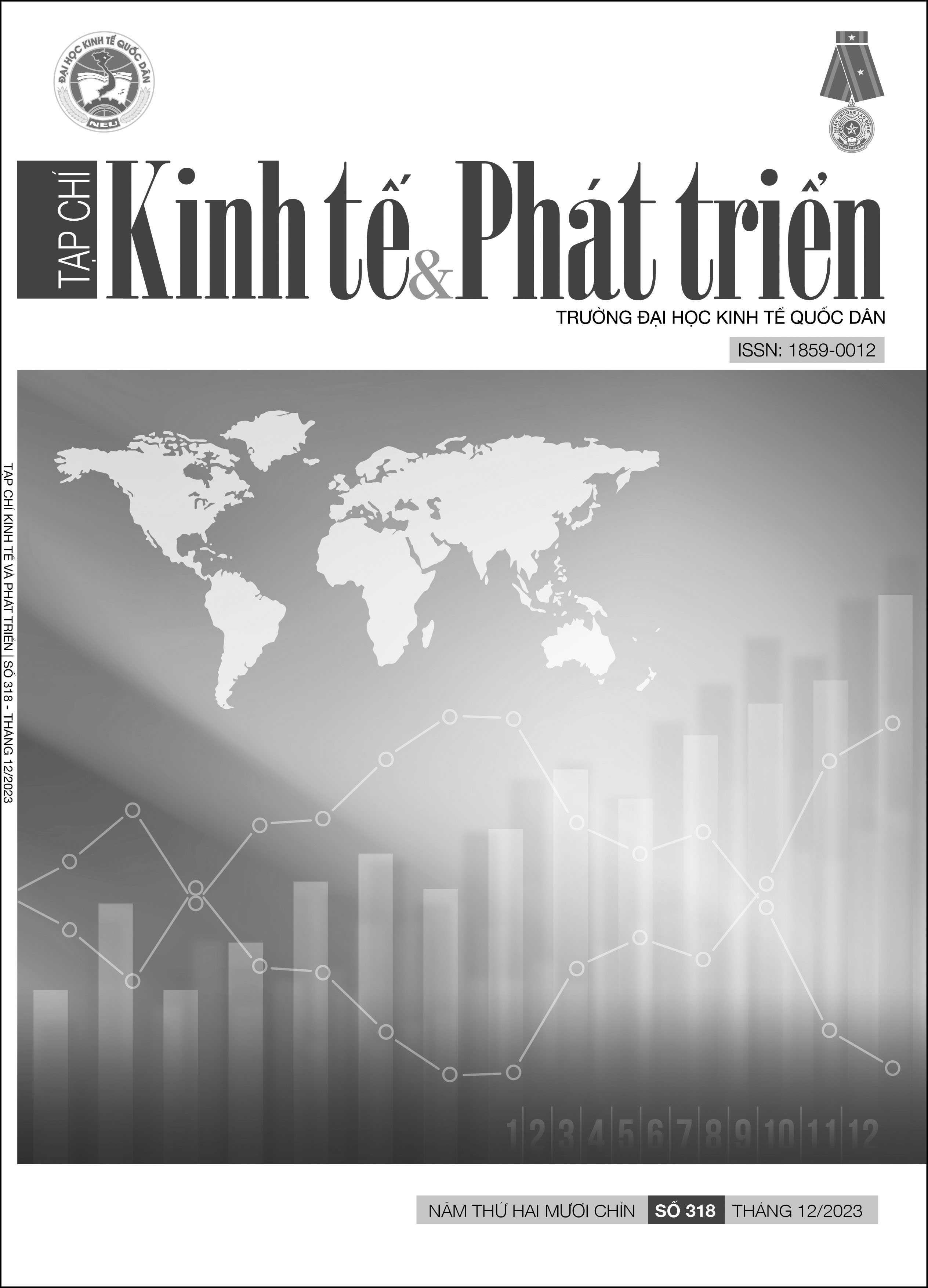Công bố thông tin ngân hàng xanh tại các ngân hàng thương mại Việt Nam
DOI:
https://doi.org/10.33301/JED.VI.1378Từ khóa:
Biến đổi khí hậu, phân tích chỉ số công bố thông tin, công bố thông tin ngân hàng xanh, phát triển bền vữngTóm tắt
Bài viết này nghiên cứu thực trạng công bố thông tin về hoạt động ngân hàng xanh của các ngân hàng thương mại niêm yết ở Việt Nam. Nghiên cứu sử dụng phương pháp phân tích chỉ số công bố thông tin đối với Báo cáo thường niên của các ngân hàng để tiến hành đánh giá thực trạng công bố hoạt động ngân hàng xanh của 20 ngân hàng thương mại niêm yết ở Việt Nam theo hướng dẫn của Bộ Tài chính tại Thông tư số 155/2015/TT-BTC và 96/2020/TT-BTC trong giai đoạn từ năm 2016 đến năm 2022. Kết quả nghiên cứu nhận thấy, chỉ có 17/20 ngân hàng thương mại công bố thông tin ngân hàng xanh vào năm 2022, các tiêu chí công bố thông tin vẫn chưa được báo cáo đầy đủ, từ đó, nghiên cứu đưa ra những khuyến nghị khả thi cho sự phát triển việc công bố thông tin ngân hàng xanh tại Việt Nam.
Tài liệu tham khảo
Agrawal, S. (2014), ‘Green banking in India: An empirical study of commercial banks’, Voice of Research, 2(4), 58-60.
Ahmed, K. & Curtis, J.K. (1999), ‘Associations between corporate characteristics and disclosure levels in annual reports: A meta analysis’, British Accounting Review, 31(1), 35-61.
Ahuja, N. (2015), ‘Green banking in India: A review of literature’, International Journal for Research in Management and Pharmacy, 4(1), 12-13.
Bahl, S. (2012), ‘Green banking – The new strategic imperative’, Asian Journal of Research in Business Economics and Management, 2(2), 176-185.
Beattie, V., McInness, B. & Fearnley, S. (2004), ‘A methodology for analyzing and evaluating narratives in annual reports: A comprehensive descriptive profile and metrics for disclosure quality attributes’, Accounting Forum, 8, 205-236.
Bose, S., Khan, H.Z., Rashid, A. & Islam, S. (2018), ‘What drives green banking disclosure? An institutional and corporate governance perspective’, Asia Pacific Journal of Management, 35(2), 501-527.
Botosan, C.A. (1997), ‘Disclosure level and the cost of capital’, The Accounting Review, 72(3), 323-349.
Chaurasia, A.K. (2014), ‘Green banking practices in Indian banks’, International Journal of Management and Commerce Innovations, 2(1), 232-235.
Choi, J. & Wang, H. (2010), ‘The effect of firm compensation structures on the mobility and entrepreneurship of extreme performers’, Business, 920, 1-43.
Clarkson, P., Elijido‐Ten, E. & Kloot, L. (2010), ‘Extending the application of stakeholder influence strategies to environmental disclosures. Accounting’, Auditing & Accountability Journal, 23(8), 1032-1059. https://doi.org/10.1108/09513571011092547.
Cooke, T.E. (1989), ‘Disclosure in the corporate annual reports of Swedish companies’, Accounting and Business Research, 19(74), 113-124.
Deegan, C.M. & Unerman, J. (2006), Financial accounting theory, McGraw Hill Education.
Ferguson, M.J., Lam, K.C.K. & Lee, G.M. (2002), ‘Voluntary disclosure by state-owned enterprises listed on the Stock Exchange of Hong Kon’, Journal of International Financial Management and Accounting, 13(2), 125-152.
Freedman, M. & Jaggi, B. (2005), ‘Global warming, commitment to the Kyoto protocol, and accounting disclosures by the largest global public firms from polluting industries’, The International Journal of Accounting, 40(3), 215-232.
Ginovsky, J. (2009), Green banking - Inside and out, Community Banker, 30-32.
Guthrie, J., Petty, R., Yongvanich, K. & Ricceri, F. (2004), ‘Using content analysis as a research method to inquire into intellectual capital reporting’, Journal of Intellectual Capital, 5(2), 282-293.
Hossain, M., Ahmad, N., Tarique, M. & Momen, A. (2016), ‘Disclosure of green banking issues in the annual reports: A study on Bangladeshi banks’, Middle East Journal of Business, 11(1), 19-28.
IMF (2000), Code of Good Practices on Transparency in Monetary and Financial Policies: Declaration of Principles, from <https://Www.Imf.Org/External/Np/Mae/Mft/Code/Index.Htm>.
Islam, M. & Das, P. (2013), ‘Green banking practices in Bangladesh’, Journal of Business and Management, 8(3), 39-44.
Khan, H.Z., Bose, S., Sheehy, B. & Quazi, A. (2021), ‘Green banking disclosure, firm value and the moderating role of a contextual factor: Evidence from a distinctive regulatory setting’, Business Strategy and the Environment, 30(8), 3651-3670. https://doi.org/10.1002/bse.2832.
Lalon, R. (2015), ‘Green banking: Going green’, International Journal of Economics, Finance and Management Sciences, 3(1), 34-35.
McKenzie, G. & Wolfe, S. (2004), ‘The impact of environmental risk on the UK banking sector’, Applied Financial Economics, 14(14), 1005-1016. https://doi.org/10.1080/0960310042000261880.
Mehedi, S., Kuddus, M. & Maniruzzaman, M. (2017), ‘The Identification of bankers’ perception toward indicators for the adoption of green banking in Bangladeshi scheduled commercial banks’, Journal of Internet Banking and Commerce, 22(2), 1-18.
Naji, A.F. & Dnya, H.F. (2022), ‘The role of green bank marketing in sustainable development : Survey study in Sulaymaniyah city’, ASJP, VIII(2), 931-949.
Prado-Lorenzo, J.M., Rodrı´guez-Domı´nguez, L., Gallego-A´lvarez, I. & Garcı´a-Sa´nchez, I.M. (2009), ‘Factors influencing the disclosure of greenhouse gas emissions in companies world-wide’, Management Decision, 47(7), 1133-1157.
Ragupathi, M. & Sujatha, S. (2016), ‘Green banking initiatives of commercial banks in India’, International Research Journal of Business and Management, VIII(2), 74-81.
Suborna, B. (2020), Principles of green banking, Deutsche Nationalbibiothek.





